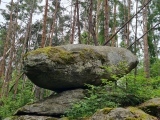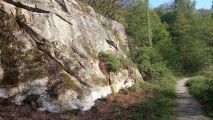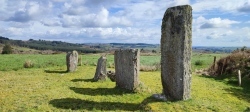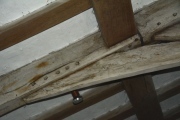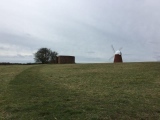Andy Burnham's Blog, page 105
May 26, 2023
Stenvad 50 Kroner Dysse
One of Denmark's most famous megalithic tombs. near Stenvad. Its name comes from the fact it was pictured on the 50 kroner bank note from 1950 to 1970. It was also on the 5 kroner note from 1937-1943 (see pic on our page).
Published on May 26, 2023 05:06
May 25, 2023
Logan Stone Vindi
A popular logan stone situated NW from the town of Krásná hora in the Czech Republic. A quite enormous piece of granite sitting on its bedrock with only a very small connecting spot. An interesting fact - the location is on the gentle southern slope of the hill "Na krámcích". That can be easily translated as "At the shops". Why "at the shops"? Read on for the answer.
Published on May 25, 2023 09:51
May 23, 2023
Loeklippen Skåltegn 1
On the hiking trail below Loeklippen on the island of Bornholm you will find a few cup marks in three places - see the Nearby Sites list on our page for more.
Due to the state of weathering, the discoverer of these cup-marks, Mogens Jensen, assumes that they are from the Stone Age.
Due to the state of weathering, the discoverer of these cup-marks, Mogens Jensen, assumes that they are from the Stone Age.
Published on May 23, 2023 03:07
May 22, 2023
Farrannahineeny
A fine alignment of five stones (some broken) ranging from 140 to 300cm high. It is beautifully situated and commands a fine view. See below on our page for details on the dimensions of the stones.
Published on May 22, 2023 00:35
May 21, 2023
The Lady Stone
This standing stone, said by some to resemble a cloaked woman, can be found in a field to the north of the A487 Cardigan to Fishguard Road just west of Dinas Cross. It is easy to find because it is situated just over a hedge in a field behind the Black Horse Inn and is just over 8 feet tall.
Published on May 21, 2023 09:41
May 20, 2023
Viking Timbers at St Olaf's Church Wasdale Head
St. Olaf's Church in the tiny hamlet of Wasdale Head claims to be one of the smallest in England with four roof trusses said to have come from Viking long ships. The churchyard is tiny and very poignant. Reading the grave markers, many of those buried here lost their lives on the surrounding fells, particularly Scawfell (old spelling).
Published on May 20, 2023 13:37
May 19, 2023
Long Man of Wilmington
The Long Man lies on the north-facing scarp slope of Windover Hill in East Sussex. He stands holding a long staff in each hand. The western staff is 72 metres long and there is a distance of over 30 metres between the two staff. Until 1873 the figure was reported as a faint indentation in the turf, visible only in low sunlight. In 1873-74 the outline was marked out in bricks. In 1969 these were replaced with pre-cast concrete blocks which still delineate the figure.
Published on May 19, 2023 04:21
Cornwall Park Rongo Stone
This basalt standing stone represents the god Rongo and may date back to the earliest settlement of New Zealand. Rongo was one of the Polynesian gods and is known throughout Polynesia. Such stones embodied the essence of Rongo, the god of cultivation and peace, and were set up in kumara and other crop fields to ensure agricultural success. Rongo stones held mauri, an energy which bound all things in the physical world and was needed to allow mana (the extraordinary power of the god) to pass to the fields and crops. As such the stones were sometimes known as kumera gods.
Published on May 19, 2023 02:54
May 18, 2023
Kenric's Stone (Llanelltyd)
In the church of St Illtyd at Llanelltyd near Dolgellau stands a stone with a footprint carved upon it and a faint Latin inscription in memory of Kenric the Pilgrim. The church stands within a circular graveyard that has a spring/well in the corner, perhaps originally the saint's well. St Illtyd (450-530) was the saint who founded a monastic college at Llantwit Major in south Glamorgan. He founded many churches, most of which are in southern and south-east Wales.
Published on May 18, 2023 14:20
May 17, 2023
Halnaker Hill
The causewayed enclosure at Halnaker Hill dated to the Neolithic is NNE-SSW aligned. The enclosure covers approximately 2ha in total area but only the southern half of the monument is open and accessible to the public - comprising approx. 0.8ha - owned and managed by West Sussex County Council. The northern part of the site is in private ownership - and there is no public access to this. Modern ploughing has reduced the bank and ditch considerably, with the earthworks on the southern and south western part of the site being the most visible.
Published on May 17, 2023 11:16


